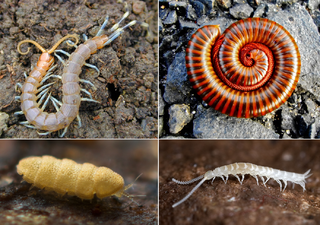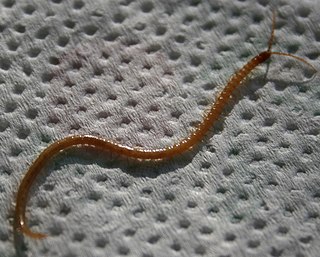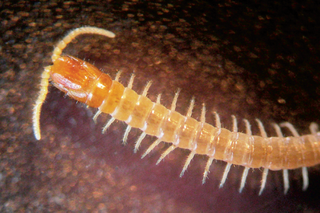
Centipedes are predatory arthropods belonging to the class Chilopoda of the subphylum Myriapoda, an arthropod group which includes millipedes and other multi-legged animals. Centipedes are elongated segmented (metameric) creatures with one pair of legs per body segment. All centipedes are venomous and can inflict painful stings, injecting their venom through pincer-like appendages known as forcipules or toxicognaths, which are actually modified legs instead of fangs. Despite the name, no centipede has exactly 100 pairs of legs; number of legs ranges from 15 pairs to 191 pairs, always an odd number.

Myriapods are the members of subphylum Myriapoda, containing arthropods such as millipedes and centipedes. The group contains about 13,000 species, all of them terrestrial.

Scutigera is a centipede genus in the scutigeromorph family Scutigeridae, a group of centipedes with long limbs and true compound eyes. It compose of more than 30 species, including the most common and well-studied Scutigera coleoptrata.

The Chinese red-headed centipede, also known as the Chinese red head, is a centipede from East Asia. It averages 20 cm (8 in) in length and lives in damp environments.

Scolopendridae is a family of large centipedes.

Scolopendra morsitans, also known as the Tanzanian blue ringleg or red-headed centipede, is a species of centipede in the family Scolopendridae. S. morsitans is the type species for the genus Scolopendra.

Geophilus flavus is a terrestrial, soil-dwelling, species of centipede in the Geophilidae family. G. flavus occurs in a range of habitats across central Europe, North America, Australia and other tropical regions. Geophilomorph centipedes, like centipedes generally, are primary predators, hunting predominantly in underground soil burrows or above ground leaf litter. Their consumption behaviours are influenced by environment and seasonal factors. Given their lack of economic value and marginal medical significance, G.flavus remains largely understudied in mainstream research. Some recent studies have detailed the evolutionary development of G.flavus and Geophilidae generally, illustrating developed predatory features like forcipule venom glands.

Scolopocryptopidae is a family of blind centipedes in the order Scolopendromorpha. This family includes more than 90 species. Centipedes in this family are found mainly in the Americas and East Asia but have also been recorded in West Africa, New Guinea, and Fiji.

The Geophilidae are a polyphyletic, cosmopolitan family of soil centipedes in the superfamily Geophiloidea containing the mostly defunct clades Aphilodontidae, Dignathodontidae, Linotaeniidae, Chilenophilinae, and Macronicophilidae. These centipedes are found almost worldwide.

Himantariidae is a monophyletic family of centipedes in the order Geophilomorpha and superfamily Himantarioidea, found almost exclusively in the Northern Hemisphere. Centipedes in this family feature a short head with a concave labral margin bearing a row of denticles, a single dentate lamella and some pectinate lamellae on each mandible, second maxillae with strongly tapering telopodites and slightly spatulate claws, and a stout forcipular segment with short forcipules and a wide tergite; the ultimate legs usually have no pretarsus, and the female gonopods are distinct and biarticulate.

Mecistocephalidae is a monophyletic family of centipedes in the order Geophilomorpha. It is the only family in the suborder Placodesmata. Most species in this family live in tropical or subtropical regions, but some occur in temperate regions. This family is the third most diverse in the order Geophiliomorpha, with about 170 species, including about 130 species in the genus Mecistocephalus.

Geophilus is a large, heterogeneous genus of soil centipedes in the family Geophilidae largely considered to be synonymous with Brachygeophilus. This genus is mostly Holarctic and characterized by a claw-shaped ultimate pretarsus, complete or nearly complete coxo-pleural sutures at the prosternum, and incomplete chitin-lines. Centipedes in this genus feature slightly elongate heads and labral intermediate parts with tubercles, the forcipules are usually poorly elongate with a single small tubercle at the base of each tarsungulum, and the anterior trunk metasternites usually have an anterior medial socket and a posterior transversally elongate pore-field. The generic name first appeared in Brewster's Edinburgh Encyclopaedia in 1814 as Geophilus electricus.

Plutonium zwierleini, in the monotypic genus Plutonium, is one of the largest scolopendromorph centipedes in Europe, and one of the few potentially harmful to humans. Nevertheless, it has been rarely reported, only from the southern part of the Iberian and Italian peninsulas, Sardinia and Sicily.

Schendylidae is a family of centipedes in the order Geophilomorpha found in the Americas, the Palearctic region, Africa, Madagascar, Australia, and southeast Asia, and also on some Pacific islands.
Arrup is a genus of centipedes in the family Mecistocephalidae, native to Europe and Asia as far as Japan. Centipedes in this genus feature small telopodites on the second maxillae, the head and forcipular segment are elongate, the clypeus is almost completely areolate, and the poison glands in adult males are often deep inside the forcipules. These centipedes range from 1 cm to 5 cm in length. All species in this genus have 41 leg-bearing segments. Most are soil-dwellers but Arrup akiyoshiensis is a troglobiont.
Agnostrup is a genus of centipedes in the family Mecistocephalidae, native to Europe and Asia. Centipedes in this genus feature small telopodites without claws on the second maxillae and a robust basal denticle on the forcipular tarsungulum. These centipedes range from 2 cm to 3 cm in length. All species in this genus have 41 leg-bearing segments.
Anarrup is a genus of centipedes in the family Mecistocephalidae, native to Europe and Asia as far as Indonesia. Centipedes in this genus feature a clypeus with areolation and setae limited to a short anterior marginal band; the second maxillae have swollen and densely setose telopodites and a coxosternite divided mid-longitudinally. These centipedes range from 6 cm to 8 cm in length. All species in this genus have 41 leg-bearing segments.
Geophilus persephones is a species of soil centipede in the family Geophilidae discovered in 1999. This species is named after Persephone, the queen of the underworld in Greek mythology, and found in caves in the Gouffre de la Pierre Saint-Martin. It has elongated antennae and legs as well as abundant sensory setae, and like other geophilomorhps it lacks sight, has a flattened trunk, and is well adapted to underground life. This species was the first troglomorphic geophilomorph ever discovered and one of the only two in existence along with Geophilus hadesi. Known from a single male specimen measuring 16.2 mm in length, this species has only 29 pairs of legs, one of only two species in the Geophilidae family to have so few leg pairs.
Geophilus richardi is a species of soil centipede in the family Geophilidae found in France, Italy, and the Ionian Islands. Females of this species have 33 pairs of legs; males have 29 or 31. This species is one of only two in the family Geophilidae to include centipedes with as few as 29 leg pairs. This species grows up to 10 millimeters long, has no carpophagus pit or pore-fields, and has a gradually tapering, curved pretarsus of the second maxillae. G. richardi lacks typical ventral pores between 2–4mm. The sternites instead bear a small number of pores between 0.5–1mm that differ from micropores, which are unbounded by a cuticular ring. These are possibly the remnants of typical ventral pores, their smaller size being a byproduct of overall miniaturization.
Arthrorhabdus mjobergi is a species of centipede in the Scolopendridae family. It is endemic to Australia, and was first described in 1916 by German naturalist Karl Kraepelin from material collected by Swedish zoologist and explorer Eric Mjöberg. It is a relatively small species, averaging 38 millimetres in length, with a pale brownish-yellow body, reddish-brown head, and variably coloured last segment and back legs. Its notable characteristics include short, 17-segmented antennae, mouthparts with 4 or 5 large outward-facing teeth, body segments with distinct median indentations, and varied leg features such as bristles at the base of claws on the first 20 pairs and 2 to 5 spines on the last pair.

















